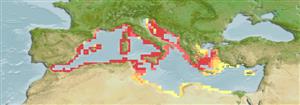Hexacorallia |
Scleractinia |
Dendrophylliidae
Environment: milieu / climate zone / गहराई सीमा / distribution range
पारिस्थितिकी
प्रवाल-भित्ति संयुक्त. Subtropical
Atlantic and the Mediterranean.
Length at first maturity / आकार / Weight / Age
परिपक्व अवधि: Lm ? range ? - ? cm
This species is a non colonial stony coral. Calcareous skeleton: reaching exceptionally 0.80 cm vertically. Diameter of the polyps: 0.7 cm to the maximum, often much less. Round section; chalice somewhat narrowed at the base. Bodies and oral disc: yellow or oranges sharp, the tentacles white; translucidus and constellated with yellow punctuations which correspond to the clusters of cnidocytes (Ref. 358).
Calcareous skeleton: reaching exceptionally 0.80 cm vertically. Diameter of the polyps: 0.7 cm to the maximum, often much less. Depth: present beyond 10 m, seldom less, and until the greatest depths (Ref. 358). Habitat: Underwater caves and anfractuosities, zones of solid drop shadow by rock overhangs, deep rock faces or not exposed with sunlight species present beyond 10 m, seldom less, and until the greatest depths (Ref. 358). Known from infra- and circalittoral zones (Ref. 85338). Biology: the chalice and the periphery of the oral disc are regularly colonized by the barnacles of the corals (Pyrgoma anglicum), species joining only the corals. Association: symphorism, or colonization is a symphorism; or durable colonization by an organization of the surface of another organization. The yellow coral does not suffer any injury; the barnacles seek doubtless protection that the tentacles irritant of the corals offer to them. It is not rare that the wall of the skeleton of the barnacles is covered by the tissues with the coral: one then any more does not distinguish on the chalice from the madréporaire that one small ball bored from an opening in his end (Ref. 358).
Life cycle and mating behavior
परिपक्व अवधि | पुनरुत्पत्ति | मछलीऔ का अंडे देना | Eggs | Fecundity | Larvae
Members of the class Anthozoa are either gonochoric or hermaphroditic. Mature gametes are shed into the coelenteron and spawned through the mouth. Life cycle: The zygote develops into a planktonic planula larva. Metamorphosis begins with early morphogenesis of tentacles, septa and pharynx before larval settlement on the aboral end.
Göthel, H. 1992 Guide de la faune sous-marine: La Méditerranée. Invertébrés marins et poissons. Eygen Ulmer GmbH & Co. 318 p. (संदर्भ 358)
IUCN Red List Status
(संदर्भ 130435: Version 2025-1)
CITES status (संदर्भ 108899)
CMS (संदर्भ 116361)
Not Evaluated
Threat to humans
Human uses
| FishSource |
साधन
अधिक जानकारी
Trophic EcologyFood items (preys)
संघटक आहार
आहार खपत
परभक्षी
Population dynamicsबाढ़Max. ages / sizesLength-weight rel.Length-length rel.Length-frequenciesMass conversionबहुतायत Life cycleपुनरुत्पत्तिपरिपक्व अवधिFecundityमछलीऔ का अंडे देनाEggsEgg developmentLarvae PhysiologyOxygen consumption
Human RelatedStamps, coins, misc.
इंटरनेट स्रोत
Estimates based on models
Preferred temperature
(Ref.
115969): 15.8 - 19.3, mean 18 (based on 32 cells).
Price category
Unknown.
